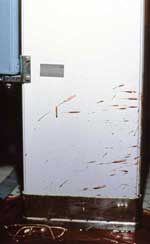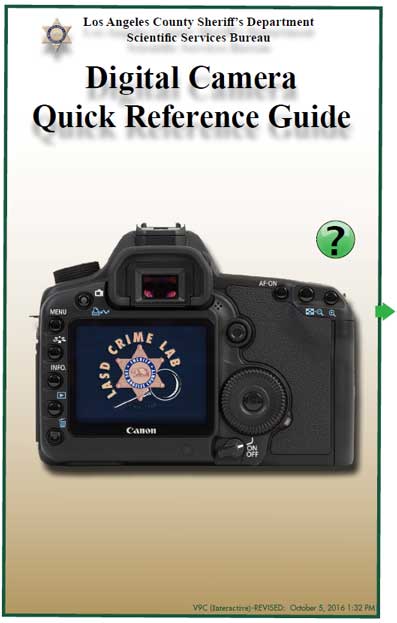 Crime Scene Investigator Network Newsletter
Crime Scene Investigator Network Newsletter
|
|
MAY 2020 |
|
|
Bloodstain Photography
Steven Staggs
Bloodstain (also referred to as blood spatter) at a crime scene can tell the story of what occurred during an assault or other type of bloody crime scene. Bloodstain analysis can determine such things as where victims and suspects were positioned when bloody blows occurred and events during the assault (e.g., which victim bled first). The crime scene photographer is responsible for photographically documenting a bloodstain scene in such detail that a bloodstain expert can later do an analysis of the bloodstain evidence. These photographs will include areas of bloodstain that indicate a pattern. An example of a pattern area is shown in the photograph below.
 When photographing with a digital camera all photographs should be taken as RAW file images in color mode. RAW files are uncompressed and will capture more detail than JPG or TIF file images. By photographing in color, subtle tones that could be lost when photographing in black-and-white mode will be captured. Later, if black-and-white images are needed, the color digital photograph can be changed into grayscale in a program such as Adobe® Photoshop®.
When photographing with a digital camera all photographs should be taken as RAW file images in color mode. RAW files are uncompressed and will capture more detail than JPG or TIF file images. By photographing in color, subtle tones that could be lost when photographing in black-and-white mode will be captured. Later, if black-and-white images are needed, the color digital photograph can be changed into grayscale in a program such as Adobe® Photoshop®.
When photographing bloodstain scenes with film, use color film to establish which substances in the photograph are bloodstains. Black-and-white film records reflected light in shades of gray, so when using black-and-white film it may be difficult to determine what substances in the photography are actually blood stains. Black-and-white film may, however, be used for high contrast photographs or with colored filters to increase contrast between the background and bloodstain. For example, if a bloodstain is located on a dark surface you can use black-and-white film and a red filter to lighten the bloodstain, or if a bloodstain is located on a light surface you can use black-and-white film and a blue filter to darken the bloodstain.
When photographing bloodstains you must first show the location of the bloodstain with mid-range photographs followed with closer views to show the bloodstain patterns. When taking close-up photographs of bloodstains be sure to place a scale on the same plane as the bloodstain. Self-adhesive scales are convenient for photographing small areas, especially vertical surfaces, but a lightweight plastic scale can be taped (using fingerprint tape) to a vertical surface when necessary.
Position the camera with the camera's film plane parallel to the bloodstain evidence. In order to get as much detail recorded on the film as possible, your camera should be positioned so the frame of your viewfinder is filled with the bloodstain and scale. Using a tripod helps with the positioning of the camera and steadies the camera.
This is important since depth-of-field is shallow in close-up photographs. Precise focusing can be made with a camera mounted on a tripod.
Proper lighting will show the detail of the bloodstain patterns and evidence. Do not attempt to photograph bloodstain with an electronic flash positioned on the camera. If you do, you will normally get reflection from the surface you are photographing. The reflection will obscure detail. The best way to light bloodstain is with oblique lighting. Oblique lighting will reduce reflections and show greater detail in the evidence. Use very low oblique light angles when dealing with bloodstain on fabrics. The most effective way to insure you are using the best angles of lighting is to "preview the photograph" by looking at lighting from several different angles. To do this, position a strong light source, such as a flashlight, at different angles to find the light angles that reveal the best detail in the tool mark. As you move the lighting you will see the results you will get by looking into your viewfinder. Position your electronic flash at the best angles for the photographs.
Some investigators will use strings to determine the origin of bloodstain at a crime scene. The origin is usually the location of a bloody blow in an assault. The technique involves measuring a group of blood drops on a surface, such as a wall, to find the angle that each drop of blood was traveling when it struck the surface. Strings are attached to the points each blood drop struck and the strings are then angled back to an approximate point of origin. Photographs are then taken to document the demonstration.
Photographs can also be taken to illustrate theories involving bloodstain evidence, such as the position of a victim at the time of a bloody blow. In the illustrations below photographs are used to show the approximate location of the victim's head at the time of a bloody blow. The first photograph shows an area of the floor that has a void pattern. The void pattern is an area without bloodstain. This pattern was caused when a partition blocked bloodstain that traveled through the air from the point of origin. The second photograph was taken without moving the camera, but with the electronic flash positioned where it was believed the victim's head was located when the bloody blow occurred. The second photograph shows a shadow, caused by the partition, that matches the void pattern. (See the photographs.)
These two photographs can be used in court to help illustrate the testimony given by a bloodstain expert regarding the position of the victim's head at the time of the bloody blow.
< read the article and view the example photographs on the Crime Scene Investigator Network website. >
The information presented in this article is from the book
Crime Scene and Evidence Photography, 2nd Edition ©2014 by Steven Staggs.
Related Content
Bloodstain Photography, by George Schiro
Bloodstain Photography, by Christopher Duncan
Using Infrared Photography to Document Clothing Evidence in the Reconstruction of a Homicide, by Michael Gorn and Stuart H. James
|
|
|
|
This Month's Featured Resource on the Crime Scene Investigator Network Website
|

Erika Di Palma, Yvette Gonzalez and Roger W. Vargo
Los Angeles County Sheriff's Department Scientific Services Bureau
This interactive guide covers the following topics:
- General crime scene photography
- Night time available light photography
- 2D shoe impressions
- 2D latent/patent impressions
- 3D shoe and tire track impressions
- Painting with light - Insufficient light or large area
- Alternate light source photography - Photography of seminal fluid
- Luminol photography
- Aerial photography
- Depth of field, shutter speed and ISO chart
The Los Angeles Sheriff's Department has made this interactive PDF available free of charge. The PDF may be saved on your smartphone for access at a crime scene. <Read/download the Publication>
|
New CSI and Forensic Job Announcements
|
The most comprehensive listing of Crime Scene Investigation and Forensic
employment opportunities on the internet! We typically have over 150 current listings! |
Crime Scene Investigator
Larimer County Sheriff, Fort Collins, Colorado, USA
Final Filing Date: May 27, 2020
Responsible for the recognition, identification, documentation, and scientific collection of all physical evidence pertinent to the investigation of a criminal act. Examines crime scenes to discover, preserve, collect, photograph, video, and identify physical evidence.
<View complete job listing>
|
Forensic Scientist
Glendale Police Department, Glendale, Arizona, USA
Final Filing Date: May 31, 2020
Photographically documents physical and biological evidence in the lab and at crime scenes. Responds to complex crime scenes to gather, preserve, and identify items of a probative nature for crime lab for analysis. Performs microscopic, chemical, and/or comparative analyses on physical evidence.
<View complete job listing>
|
Crime Scene Investigator Trainee
Hillsborough County Sheriff's Office, Tampa, Florida, USA
Final Filing Date: Open until filled
Learn to conduct major crime scene investigations to locate, identify, preserve, photograph, and prepare evidence for submission to crime laboratories for analysis. Function in a trainee capacity to gain proficiency in the duties and responsibilities and become eligible for promotion to Crime Scene Investigator upon successful completion of the trainee program.
<View complete job listing>
|
Property and Evidence Technician
Evans Police Department, Evans, Colorado, USA
Final Filing Date: Open until filled
Performs complex technical, clerical and security work in the Property and Evidence Room. The Technician is responsible for the security of the Property and Evidence area and contents.
<View complete job listing>
|

|
Forensic Photo Imaging Laboratory Technician
Riverside County Sheriff's Department, Perris, California, USA
Final Filing Date: May 21, 2020
Incumbents perform analysis and editing techniques on digital photographic evidence in a laboratory environment, as well as perform routine maintenance on digital imaging equipment and work as the administrator to both the Digital Crime Scene (DCS) system and the FARO 3D measurement system.
<View complete job listing>
|
Latent Print Examiner
Oceanside Police Department, Oceanside, California, USA
Final Filing Date: May 29, 2020
The Latent Print Examiners analyze known and latent prints for comparison purposes; operate all computers and computer-related equipment associated with automated fingerprint identification systems; perform development of latent prints on objects using a variety of physical, chemical and/or optical methods;
<View complete job listing>
|
Forensic Scientist I - DNA
Massachusetts State Police, Maynard, Massachusetts, USA
Final Filing Date: This requisition will remain open until filled; however, first consideration will be given to those applicants that apply by May 25, 2020
Complete comprehensive training in current methods and techniques used to conduct chemical and biological laboratory or on-site tests including, but not limited to, analyzing biological specimens and organic and inorganic substances; preparing solutions to be used in testing; and operating laboratory equipment. Develop proficiency in ...
<View complete job listing>
|
Scientific Evidence Division Manager
Albuquerque Police Department, Albuquerque, New Mexico, USA
Final Filing Date: May 22, 2020
Assist the Division Commander with the direction, management and coordination of assigned programs and activities within the Criminalistics Laboratory, consisting of the DNA Unit, Latent Fingerprint Unit, Firearms and Tool mark Unit, Chemistry and Blood/Breath Alcohol Unit and the New Mexico DNA Identification System (CODIS).
<View complete job listing>
|
|
|
|
Other Resources on the Crime Scene Investigator Network Website
|
|
|
|
Not Subscribed to this Newsletter?
|
|
|
|
To Unsubscribe
|
Crime Scene Investigator Network
PO Box 1043
Wildomar, CA 92595-1043
|



 When photographing with a digital camera all photographs should be taken as RAW file images in color mode. RAW files are uncompressed and will capture more detail than JPG or TIF file images. By photographing in color, subtle tones that could be lost when photographing in black-and-white mode will be captured. Later, if black-and-white images are needed, the color digital photograph can be changed into grayscale in a program such as Adobe® Photoshop®.
When photographing with a digital camera all photographs should be taken as RAW file images in color mode. RAW files are uncompressed and will capture more detail than JPG or TIF file images. By photographing in color, subtle tones that could be lost when photographing in black-and-white mode will be captured. Later, if black-and-white images are needed, the color digital photograph can be changed into grayscale in a program such as Adobe® Photoshop®.